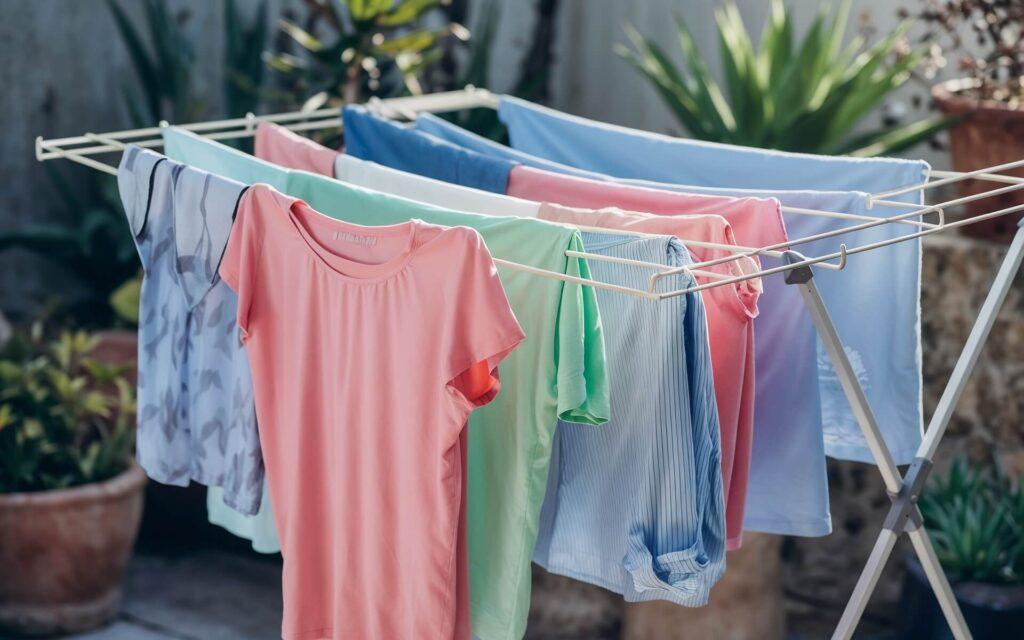Men’s Guide to Clothing Care and Storage for Lasting Wear
We’ve all been there—your favorite shirt starts to fade after just a few washes, or your go-to pair of jeans begins to show wear at the seams. It’s frustrating, right? The good news is that with a little extra care, you can extend the life of your clothing, saving money and reducing waste along the way. In this guide, we’ll walk through practical, no-nonsense tips on how to wash, dry, store, and maintain your clothes to keep them looking fresh for longer. So, without further ado, let’s get started!
Contents
1. How to Properly Wash Your Clothes
Washing your clothes the right way is the foundation of making them last longer. It’s not complicated, but following some basic steps can make a huge difference.

Read the Labels
The first rule is simple: always check the care labels. They’re there for a reason, and they’ll tell you exactly what your garment needs. Look for symbols that indicate whether your item should be washed in cold or warm water if it’s safe to tumble dry, or if it requires hand washing.
Not sure what the symbols mean? Here’s a quick guide:
- A bucket symbol = Wash.
- A triangle = Bleach allowed (but usually best avoided).
- A square with a circle = Tumble dry.
- An iron icon = Safe to iron.
Separate by Fabric Type and Color
This may sound basic, but it’s often overlooked.
- Always separate whites, colors, and darks to avoid bleeding dyes.
- Additionally, wash delicate fabrics (like silk or lace) separately from tougher materials like denim or towels.
Why? Different fabrics require different water temperatures and washing cycles to avoid damage.
Recommendation: Invest in mesh laundry bags for delicates to keep them safe in the wash. You can find affordable options like these laundry bags on Amazon.
Use the Right Detergent
Not all detergents are created equal. Some are specifically designed for delicate fabrics, others for dark colors or sportswear.
- Use a gentle detergent for wool, silk, or hand-wash fabrics.
- Opt for color-protecting detergent for dark clothes to prevent fading.
Water Temperature Matters
- Cold water is best for most clothes, especially darks, as it prevents fading and shrinking.
- Warm water can be used for whites and lighter colors but avoid hot water unless necessary (e.g., washing towels or bedding).
Avoid Overloading the Machine
When you stuff too many clothes in the washing machine, they don’t have room to move around, which means they won’t get as clean. Worse, it can cause wear and tear due to the friction.
2. Drying and Ironing Techniques
How you dry your clothes is just as important as how you wash them. The wrong drying method can shrink, fade, or damage your favorite items.

Air-Drying vs. Machine-Drying
- Air drying is always gentler on your clothes. Hang garments like shirts, dresses, and delicate fabrics on a clothesline or drying rack to maintain their shape.
- If you must use a dryer, tumble dry on low heat and take clothes out when they’re still slightly damp to avoid over-drying, which can cause fibers to weaken.
Recommendation: Invest in a good drying rack. It’s a one-time purchase that will save your clothes from wear and tear over time.
Use the Right Dryer Settings
Each dryer cycle is designed for different fabrics.
- Low heat for delicate fabrics.
- Medium to high heat for towels and bedding.
- Permanent press for dress shirts and pants to avoid too many wrinkles.
Avoid Over-Drying
Take your clothes out of the dryer before they’re bone-dry. Not only does this prevent shrinking, but it also reduces the static cling that tends to attract dust and dirt, keeping your clothes cleaner for longer.
Ironing Dos and Don’ts
- Always check the fabric type before ironing. Delicate fabrics like silk should be ironed on a low heat setting, or better yet, steamed to prevent scorching.
- Use a pressing cloth for delicate fabrics to avoid direct heat.
- For cottons and linens, iron them while they’re still slightly damp for the best results.
3. Smart Clothing Storage Solutions
How you store your clothes is just as critical as how you wash them. Proper storage can prevent wrinkles, stretching, and even damage from pests like moths.
Proper Hanging Techniques
- Use wooden or padded hangers for heavier garments like suits, jackets, and dresses to avoid shoulder bumps and stretching.
- Thin, non-slip velvet hangers are ideal for lighter clothes like blouses or shirts to keep them in place without stretching the fabric.
Recommendation: Velvet non-slip hangers are a game-changer for keeping clothes in shape.
Folding Techniques

Some clothes, like sweaters or t-shirts, are better folded than hung. Here’s why:
- Hanging heavy knitwear can cause it to stretch out. Fold sweaters to maintain their shape.
- Folding jeans instead of hanging prevents unnecessary creases.
Storing Seasonal Clothes
For clothes you won’t wear for a while, like winter coats or summer dresses:
- Clean them before storing to avoid attracting pests.
- Use breathable fabric storage bags instead of plastic to prevent moisture build-up, which can lead to mold and mildew.
Don’t Overpack Your Closet
Allow enough space for your clothes to hang freely. Overcrowding can cause wrinkling, creasing, and makes it harder to see what you own.
4. Tips for Preventing Clothing Damage
Even with the best care, your clothes will eventually wear out. However, there are steps you can take to slow down the process.
Rotate Your Wardrobe
Wearing the same few items all the time can cause them to wear out faster. By rotating your wardrobe, you give your clothes time to rest, which reduces the wear and tear from frequent use.

Repair Before It’s Too Late
Got a loose button or small tear? Don’t wait until the damage gets worse.
- Learn basic sewing skills to fix small rips and replace missing buttons.
- For larger repairs, it may be worth taking your items to a tailor.
Handle Stains Immediately
- For grease stains, sprinkle a little baking soda on the spot to absorb the oil.
- Sweat stains can be pre-treated with a mixture of baking soda and water before washing.
Invest in Quality
This might sound counterintuitive, but buying better quality clothes upfront will save you in the long run. High-quality items are often made with durable fabrics and superior craftsmanship, meaning they’ll last longer with proper care.
5. Protecting Your Clothes from Pests
There’s nothing worse than pulling out a sweater only to find it full of moth holes. Here’s how to prevent that from happening:
Common Clothing Pests
- Moths and silverfish are the two most common pests that damage clothes, particularly wool and other natural fibers.
Use Natural Repellents
- Cedar blocks and lavender sachets are natural ways to keep moths away. Unlike mothballs, they smell nice and don’t contain harmful chemicals.
- Store your wool and cashmere clothes in airtight containers or garment bags.
Clean Closets Regularly
Vacuum and dust your closet regularly to keep pests at bay. Moths thrive in dark, undisturbed spaces, so frequent cleaning is key.
6. When To Say Goodbye To Clothing
Sometimes, no matter how much care you put into your clothes, it’s time to let go. But that doesn’t mean they need to end up in the trash.
Know When It’s Time To Donate or Recycle
If a piece of clothing is beyond repair or no longer fits, consider donating it to a local charity. Many organizations also accept clothing for recycling.
How To Recycle Old Clothes
- Repurpose old t-shirts into cleaning rags.
- Many brands and stores offer clothing recycling programs where you can drop off worn-out clothes for recycling.
Wrapping Up
By following these simple yet effective tips, you’ll not only extend the life of your favorite clothes but also reduce the amount of waste generated by fast fashion. Small changes, like washing with care, using the right hangers, and investing in quality items, can make a huge difference in your wardrobe’s lifespan. Start with one or two of these tips today and watch your clothing last longer than ever.
FAQ
1. How often should I wash my clothes to make them last longer?
It depends on the type of clothing. Items like jeans, sweaters, and jackets don’t need to be washed after every wear—every 4-5 wears is usually fine. However, t-shirts, underwear, and gym clothes should be washed after each use to maintain hygiene.
2. What’s the best way to remove tough stains from delicate fabrics?
For delicate fabrics like silk or wool, it’s best to use a gentle stain remover or spot treat with a mild detergent. Always dab the stain gently rather than rubbing it to avoid damaging the fibers. If you’re unsure, it’s safer to take the item to a professional cleaner.
3. Can I machine wash my wool and cashmere items?
It’s generally not recommended to machine wash wool and cashmere, as they can shrink or lose shape. Hand washing with cold water and a special wool detergent is your best bet. If machine washing is necessary, use the delicate cycle with cold water, and place the item in a mesh laundry bag.
4. How can I prevent fading in my dark-colored clothes?
To prevent fading, wash dark-colored clothes inside out in cold water using a color-protecting detergent. Avoid over-drying in the dryer, as heat can cause colors to fade faster. Air drying is often the best option for dark items.
5. How do I know when to dry clean instead of washing at home?
Clothes that are labeled “Dry Clean Only” should generally be taken to the dry cleaners, especially items made of silk, wool, and formalwear. If you’re unsure or dealing with delicate fabrics, it’s better to err on the side of caution and opt for dry cleaning.
6. How can I keep my clothes smelling fresh while in storage?
Using natural repellents like cedarwood or lavender sachets can help keep clothes fresh and protect them from pests. Make sure the clothes are clean before storing them, and consider placing a fabric softener sheet in the storage area for a fresh scent.
7. How do I prevent wrinkles without ironing?
Using a handheld steamer is a quick and safe way to remove wrinkles from clothes without ironing. Hanging your clothes in the bathroom while you shower can also help release wrinkles due to the steam. Another tip is to shake out your clothes immediately after washing and smooth them with your hands before air-drying.
8. Can I store my clothes in plastic bags or containers?
Avoid storing clothes in plastic bags for long periods, as they can trap moisture and lead to mold or mildew growth. Opt for breathable fabric storage bags or plastic containers with ventilation to keep your clothes fresh and protected.
That’s it! Now you’re ready to care for your clothes like a pro. Give these tips a try and see the results—you’ll thank yourself (and your wallet) later.